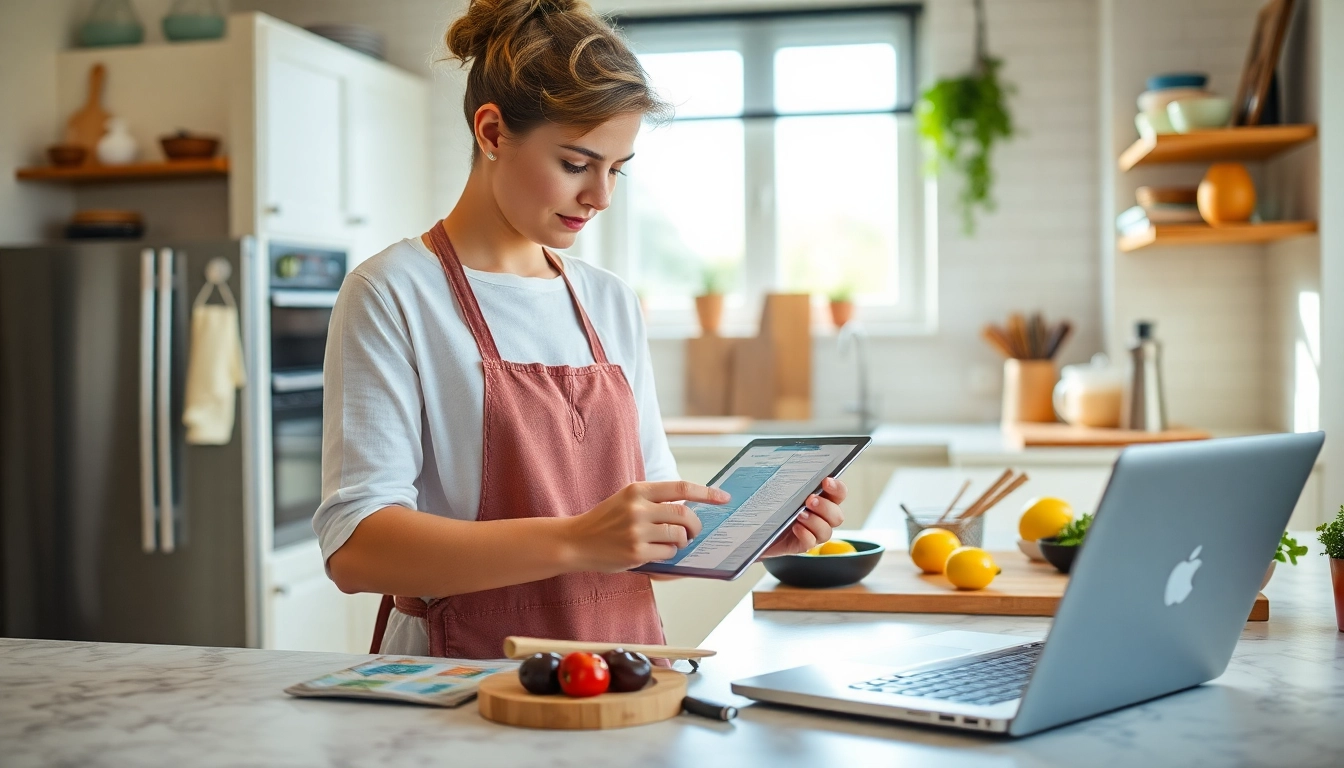Understanding the Basics of Building Your Own Cookbook
What Does “Build My Own Cookbook” Really Mean?
Building your own cookbook goes beyond simply gathering recipes; it is about creating a personalized culinary collection that reflects your tastes, traditions, and experiences. In essence, it’s a digital or physical compilation tailored uniquely to you—whether it contains family recipes, dishes from your travels, or favorite meals discovered online. The concept emphasizes control and customization, enabling you to curate a collection that is accessible, organized, and inspiring for your cooking journey. Unlike traditional cookbooks that are pre-printed with a fixed selection of recipes, building your own cookbook leverages digital tools and platforms to gather, organize, and sometimes even enhance your recipes—making it an ongoing, dynamic project that evolves with your culinary adventures.
One of the most empowering aspects of this process is the ability to build my own cookbook from any source. You can import recipes from social media posts, culinary blogs, cooking websites, or even handwritten family notes. This flexibility ensures your collection is comprehensive and truly personal, providing immediate access to a wide array of culinary inspirations without the limitations of traditional printed books.
Key Benefits of Creating a Personalized Recipe Collection
- Complete Customization: Tailor your collection to include your favorite recipes, family heirlooms, or dietary-specific dishes, arranged precisely how you prefer.
- Enhanced Organization: Digital tools allow tagging, categorizing, and searching, transforming a cluttered collection into a well-structured resource.
- Accessibility and Portability: Access your recipes anytime, anywhere—on your phone, tablet, or computer—without carrying bulky physical books.
- Seamless Updates and Expansion: Easily add new recipes or modify existing ones, keeping your collection fresh and relevant.
- Data Ownership and Privacy: Unlike proprietary platforms, your data remains under your control, ensuring privacy and security.
- Sharing and Collaboration: Collaborate with family members or friends by sharing recipes or creating joint cookbooks for special occasions.
Common Challenges in DIY Cookbook Creation
While building a personalized cookbook offers numerous advantages, it also presents certain challenges:
- Source Fragmentation: Recipes are scattered across various platforms, making it difficult to compile them cohesively.
- Consistency and Formatting: Standardizing recipes from diverse sources can be time-consuming and technically demanding.
- Data Loss or Duplication: Managing duplicates and ensuring no recipes are lost during transfer or updates require careful organization.
- Technical Proficiency: Some platforms or tools demand a learning curve, especially for users unfamiliar with digital app integrations.
- Copyright and Attribution: Ensuring proper rights and attribution when using recipes from external sources.
Overcoming these challenges involves selecting the right tools, such as Cooksync, which simplifies importing, organizing, and syncing recipes across platforms—ensuring your effort results in a reliable and easy-to-maintain digital cookbook.
Step-by-Step Guide to Assembling a Custom Cookbook
Selecting Your Favorite Recipes and Sources
The foundation of a great personalized cookbook lies in choosing recipes that resonate with your culinary identity. Begin by gathering favorites from diverse sources:
- Traditional family recipes passed down through generations.
- Recipes from cookbooks, blogs, or social media posts that inspire you.
- New dishes from restaurants or travel experiences.
- Diet-specific or allergy-friendly recipes tailored to your health needs.
As you accumulate recipes, consider categorizing them—appetizers, mains, desserts, beverages, or by dietary type—to facilitate easy navigation and future expansion.
Using Cooksync to Collect and Import Recipes
Once you’ve identified your sources, leveraging Cooksync streamlines the process of gathering and consolidating recipes. Its features include:
- Chrome Extension and iOS App: Quickly import recipes from any website or social media post with a single click, preserving original formatting and images.
- Manual Link Adding: For recipes stored in private documents or platforms without direct integration, manually add links or notes to ensure comprehensive collection.
- Universal Compatibility: Cooksync’s growing list of supported platforms means your recipes can seamlessly sync with your preferred storage spaces like Evernote, Notion, Dropbox, or your favorite cloud-based apps.
For instance, after browsing a recipe on your browser, clicking the Cooksync extension captures the content, which then automatically syncs to your designated platform, ensuring consistency and saving time.
Organizing and Customizing Your Digital Cookbook
Proper organization transforms your recipe collection from chaos into clarity. Utilize Cooksync’s features to:
- Tag Recipes: Assign labels like cuisine type, main ingredients, difficulty level, or dietary preferences.
- Create Sections or Categories: Segment recipes into chapters or themes—e.g., Holiday Favorites, Quick Weeknight Dinners, Vegan Staples.
- Add Personal Notes and Photos: Enhance each recipe with your modifications, tips, or family anecdotes.
- Set Priorities: Mark certain recipes as favorites or frequently used for quick access.
Implementing these organization strategies ensures that your recipe collection is not only comprehensive but also curated for effortless retrieval and inspiration.
Effortless Syncing and Storage Solutions
Connecting Cooksync to Your Preferred Platforms
One of Cooksync’s core strengths is its ability to connect seamlessly with a variety of platforms for storage and note-taking. Supported platforms include Evernote, Notion, Google Drive, OneNote, and more. The setup process involves authorizing Cooksync to access your accounts, enabling automatic and ongoing syncing of your recipes. This eliminates manual exporting and importing, saving you time and reducing errors.
As platforms evolve, Cooksync continually expands its supported ecosystem. You can review the complete list and API options in their documentation or request new exporters via email, ensuring your setup remains aligned with your preferred digital environment.
Automating Recipe Delivery to Your Favorite Spaces
Once connected, Cooksync automates the transfer of recipes, so every time you import or save a new dish, it is delivered directly to your chosen platform. Whether you prefer a dedicated recipe folder in Google Drive or organized pages in Notion, your culinary collection remains synchronized across devices and accounts.
This automation reduces redundancy and guarantees your recipes are always up-to-date and accessible, no matter which device or platform you use.
Ensuring Data Privacy and Control
Security and privacy are paramount when managing personal data. Cooksync provides users full control over their recipes, with storage centralized in their chosen platforms. Data is transferred securely via encrypted APIs, and users retain ownership of all recipes. Furthermore, you can audit permissions, revoke access, and delete recipes at any time.
By prioritizing transparency and user control, Cooksync ensures that your culinary data remains private and protected, giving you peace of mind as you build, curate, and share your cookbook.
Maximizing Your Cookbook’s Potential
Personalizing with Photos and Notes
Adding personal touches transforms a simple recipe collection into a cherished keepsake. Upload high-quality images of completed dishes, ingredient shopping lists, or preparation steps to enhance visual appeal and comprehension. Notes can include substitutions, flavor variations, or special tips learned through experience, making each recipe uniquely yours.
For example, annotating a recipe with a note like “Add a pinch of smoked paprika for depth” can turn routine cooking into an intuitive, personalized process.
Sharing Your Creation with Family and Friends
Sharing digital cookbooks can elevate family bonding or provide thoughtful gifts. Use export features, printable templates, or collaborative platforms to share individual recipes, themed collections, or comprehensive cookbooks. Platforms like Cooksync make it simple to share links or copies via email, social media, or printed formats—making your culinary treasures accessible to loved ones, no matter where they are.
Using Feedback to Improve and Expand Your Collection
Encourage feedback from family, friends, or cooking community members. Adjust or add recipes based on their suggestions and experiences to keep your collection relevant and engaging. Incorporate new cooking techniques, seasonal ingredients, or trending cuisines to stay inspired.
Regularly revisiting and refining your cookbook ensures it remains a vibrant, useful resource that grows along with your culinary skills and interests.
Strategies to Make Your Build My Own Cookbook Truly Unique
Design Tips and Creative Layout Ideas
Appearance matters when turning your collection into a delightful presentation. Use consistent fonts, color schemes, and imagery to develop a cohesive look. Incorporate themed covers or background templates if you plan to print your cookbook, or use digital organizational tools to create visually appealing layouts.
Consider categorizing recipes visually with icons or color codes—an approach that enhances readability and aesthetics. For instance, highlight vegan recipes in green, quick meals in yellow, or family heirlooms with a custom badge.
Incorporating Family Traditions and Stories
Every family has unique culinary stories and traditions. Document these alongside recipes to create a narrative-rich collection. Include handwritten notes, stories about the origins of specific dishes, or memories associated with holiday recipes. This personalization transforms a standard cookbook into a treasured heirloom.
Turning Your Cookbook into a Gift or Revenue Source
Unique cookbooks make heartfelt gifts or even small business ventures. Consider self-publishing through print-on-demand services, adding personal branding, or creating themed collections for special occasions. Adding a narrative or professional photography can elevate a digital collection into a beautiful, market-ready product. Crowdfunding platforms or niche markets can help monetize your designs if you wish to turn your passion into profit.
Additionally, leveraging feedback and analytics from your digital cookbook’s usage can inform future editions or product offerings, enriching your entrepreneurial endeavors.


